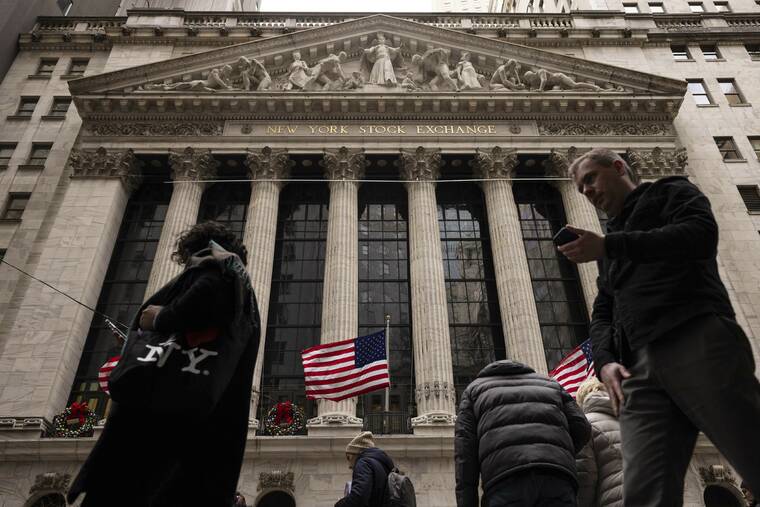Stocks end higher ahead of year’s final Federal Reserve meeting

ASSOCIATED PRESS
People walk past the New York Stock Exchange, today, in New York.
Stocks on Wall Street finished modestly higher today ahead of the Federal Reserve’s final meeting of the year.
The S&P 500 rose 0.4% after drifting between small gains and losses in the early going. The benchmark index finished at its highest level in 20 months.
The Dow Jones Industrial Average also added 0.4%, while the Nasdaq composite finished 0.2% higher.
The gains were broad among S&P 500 stocks, with technology, financial and health care among the big winners. Communications services stocks were the only laggard.
Cigna surged 16.7% for the biggest gain among S&P 500 stocks after the health insurer announced a $10 billion stock buyback, and the Wall Street Journal reported that the company is no longer pursuing a merger with Humana.
Macy’s jumped 19.4% following reports that an investor group is launching a bid to take the storied retailer private for $5.8 billion.
Don't miss out on what's happening!
Stay in touch with top news, as it happens, conveniently in your email inbox. It's FREE!
All told, the S&P 500 rose 18.07 points to 4,622.44. The Dow gained 157.06 points to 36,404.93 and the Nasdaq added 28.51 points to close at 14,432.49.
The latest gains, while muted, follow a six-week winning streak by the major stock indexes. The S&P 500 is up 20.4% for the year and the Nasdaq is up 37.9%.
Wall Street’s big focus this week will be updates on inflation at the consumer and wholesale levels, along with the Fed’s latest update on its interest rate policy.
On Tuesday, the government will release its November report on consumer inflation. Analysts expect the report to show that inflation continued slowing to 3.1% from 3.2% in October. On Wednesday, the government will release its November report on inflation at the wholesale level, which is also expected to show that the rate of inflation is easing.
The inflation data comes ahead of the Fed’s latest statement on interest rates Wednesday afternoon. The central bank is expected to hold its benchmark rate steady for a third consecutive time after spending much of 2022 and a large portion of 2023 aggressively raising rates to their highest levels in two decades.
Wall Street is overwhelmingly betting that the Fed will keep its benchmark interest rate at a range of 5.25% to 5.50% into early 2024 and could start cutting rates by the middle of that year. Analysts are also becoming more comfortable with the possibility that the central bank can pull off a “soft landing,” which refers to inflation easing under high interest rates without the economy falling into a recession.
“With inflation coming down faster than expected, it now appears likely that the Fed will refrain from additional rate hikes,” said Brian Rose, senior U.S. economist at UBS, in a note to investors. “At the same time, inflation is still too high and the labor market is still too tight for the Fed to consider cutting rates soon.”
Strong consumer spending and a solid jobs market have provided a bulwark to the broader economy, where growth has slowed but has so far avoided stalling. The government’s jobs report on Friday showed that U.S. employers added more jobs last month than economists expected. Workers’ wages also rose more than expected, and the unemployment rate unexpectedly improved.
The latest round of corporate earnings is mostly behind Wall Street and proved to be surprisingly good. Companies in the S&P 500 reported earnings growth of just under 5% during the third quarter, according to FactSet. That follows three straight quarters of earnings contractions.
Several big companies will report their earnings this week and are among the few remaining to release their results. Software company Adobe will report on Wednesday and Olive Garden owner Darden Restaurants will release its results on Friday.
Treasury yields were little changed. The yield on the 10-year Treasury held steady at 4.23%.
Crude oil prices were stable.
Markets in Asia closed mostly higher, while markets in Europe ended mixed.



